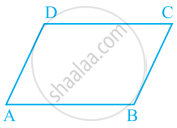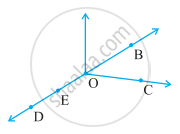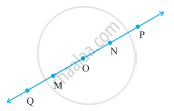Advertisements
Advertisements
प्रश्न
Answer the questions with the help of a given figure.

- State the points which are equidistant from point B.
- Write a pair of points equidistant from point Q.
- Find d(U, V), d(P, C), d(V, B), d(U, L).
उत्तर
(i) The co-ordinates of points B and C are 2 and 4 respectively.
We know that 4 > 2
∴ d(B, C) = 4 − 2
∴ d(B, C) = 2
The co-ordinates of points B and A are 2 and 0 respectively.
We know that 2 > 0
∴ d(B, A) = 2 − 0
∴ d(B, A) = 2
Since d(B, A) = d(B, C), then points A and C are equidistant from point B.
The co-ordinates of points B and D are 2 and 6 respectively.
We know that 6 > 2
∴ d(B, D) = 6 − 2
∴ d(B, D) = 4
The co-ordinates of points B and P are 2 and −2 respectively.
We know that 2 > − 2
∴ d(B, P) = 2 − (− 2)
∴ d(B, P) = 2 + 2
∴ d(B, P) = 4
Since d(B, D) = d(B, P), then points D and P are equidistant from point B.
(ii) The co-ordinates of points Q and U are −4 and −5 respectively.
We know that −4 > −5
∴ d(Q, U) = − 4 − (− 5)
∴ d(Q, U) = − 4 + 5
∴ d(Q, U) = 1
The co-ordinates of points Q and L are −4 and −3 respectively.
We know that − 3 > − 4
∴ d(Q, L) = −3 − (− 4)
∴ d(Q, L) = −3 + 4
∴ d(Q, L) = 1
Since d(Q, U) = d(Q, L), then points U and L are equidistant from point Q.
The co-ordinates of points Q and R are −4 and −6 respectively.
We know that − 4 > − 6
∴ d(Q, R) = −4 − (−6)
∴ d(Q, R) = −4 + 6
∴ d(Q, R) = 2
The co-ordinates of points Q and P are −4 and −2 respectively.
We know that −2 > − 4
∴ d(Q, P) = −2 − (− 4)
∴ d(Q, P) = −2 + 4
∴ d(Q, P) = 2
Since d(Q, R) = d(Q, P), then points R and P are equidistant from point Q.
(iii) The co-ordinates of points U and V are −5 and 5 respectively.
We know that 5 > − 5
∴ d(U, V) = 5 − (− 5)
∴ d(U, V) = 5 + 5
∴ d(U, V) = 10
The co-ordinates of points P and C are −2 and 4 respectively.
We know that 4 > −2
∴ d(P, C) = 4 − (− 2)
∴ d(P, C) = 4 + 2
∴ d(P, C) = 6
The co-ordinates of points V and B are 5 and 2 respectively.
We know that 5 > 2
∴ d(V, B) = 5 − 2
∴ d(V, B) = 3
The co-ordinates of points U and L are −5 and −3 respectively.
We know that − 3 > − 5
∴ d(U, L) = −3 − (−5)
∴ d(U, L) = −3 + 5
∴ d(U, L) = 2
APPEARS IN
संबंधित प्रश्न
Construct a line segment using ruler and compass.
AB = 7.5 cm
If line PQ || line m, then line segment PQ || m.
Name all the line segments in figure
Name the points and then the line segments in the following figure:
Which points in figure, appear to be mid-points of the line segments? When you locate a mid-point, name the two equal line segments formed by it.
Will the measure of ∠ABC and of ∠CBD make measure of ∠ABD in figure?
In which of the following figures, perpendicular bisector is shown?
In given figure how many line segments are there? Name them.
Use the figure to name Five line segments.

Consider the following figure of line \[\overleftrightarrow{MN}\]. Say whether the following statement is true or false in the context of the given figure.

O and N are end points of line segment `overline"OP"`.
